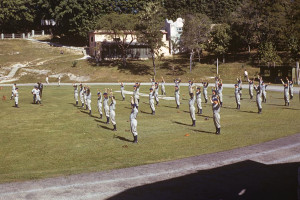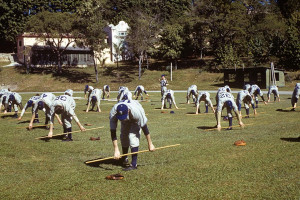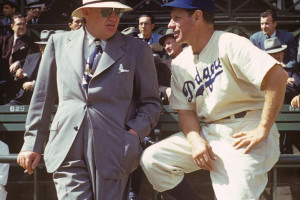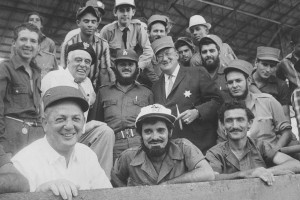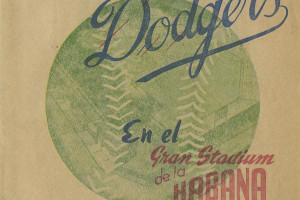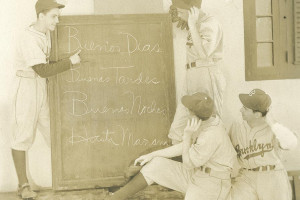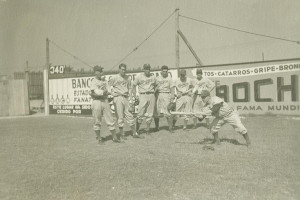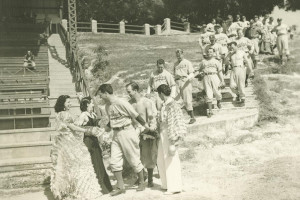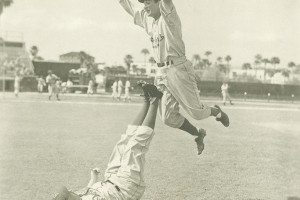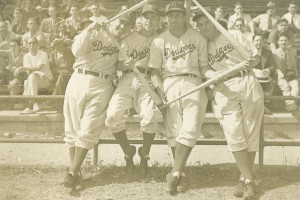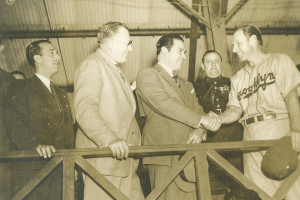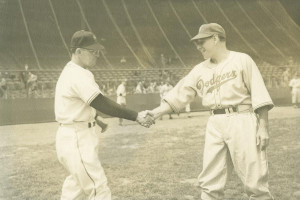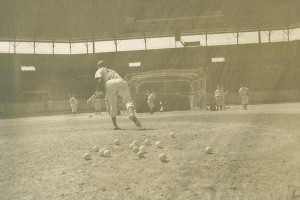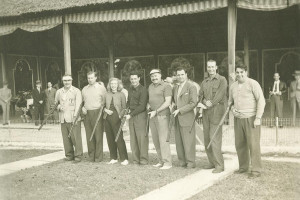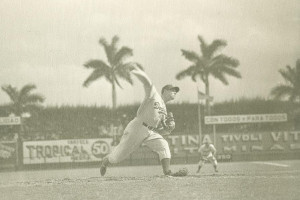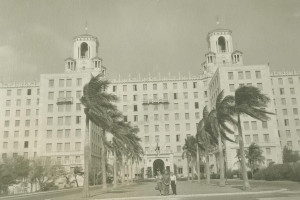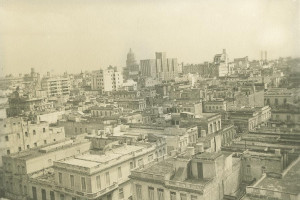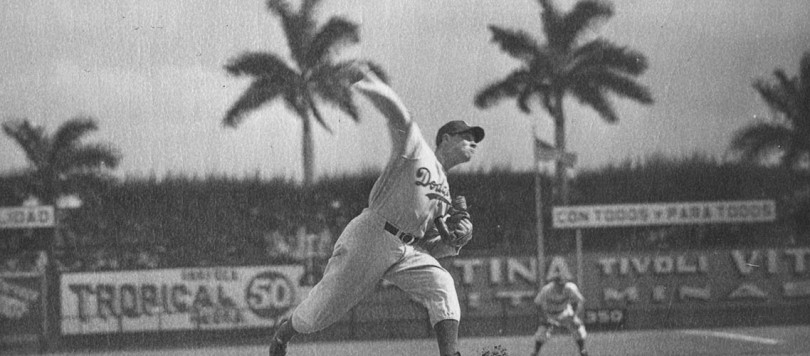
Brooklyn Dodger right hand pitcher Kirby Higbe is pitching in a game for the Dodgers during an early 1940s Spring Training visit to Cuba. In his autobiography, “The High Hard One,” Higbe wrote of evenings in Cuba with writer Ernest Hemingway.
Feature
The Dodgers and Cuba
Prior to establishing Dodgertown, Vero Beach, Florida as their Spring Training base in 1948, the Dodgers trained in Cuba three times, including in 1941, 1942, and 1947. Then Dodger President Branch Rickey sought an isolated location to accommodate Jackie Robinson, the player who would courageously break the color barrier in Major League Baseball on April 15, 1947. From 1900, the Dodgers gained popularity in Cuba, as they frequently played exhibition games there. In 1941-42, the Dodgers held Spring Training camps in Havana. Cuba’s rabid baseball fans appreciated colorful Dodger players like Van Lingle Mungo, Pee Wee Reese, Dolph Camilli and Leo Durocher.
In 1948, the Dodgers transformed the abandoned Naval Air Station in Vero Beach, used in World War II for night fighter pilots, for Spring Training activities. While they had 26 minor league teams and more than 650 players at Dodgertown, the major league Dodgers spent the majority of the spring preparing for the season in the Dominican Republic. On March 31 and April 1, the first major league games were played at Dodgertown and that’s when Robinson debuted in Vero Beach, making it the first and only integrated Spring Training site in the South.
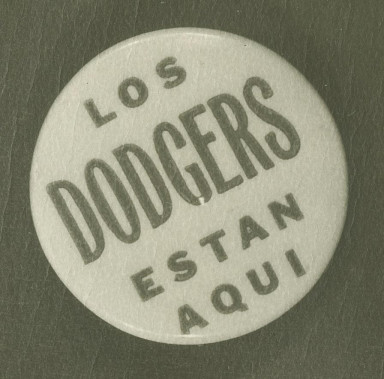
To publicize their Spring Training trip to Havana, Cuba, the Brooklyn Dodgers had buttons made in Brooklyn and distributed them all over the island. The Spanish is translated to English to mean “The Dodgers Are Here.”
During Spring Training 1959, torrential and continuous rain for six straight days played havoc on the Dodger schedule and their ability to get work done at Dodgertown. Just after Fidel Castro took control of Cuba, Dodger President Walter O’Malley hastily made arrangements for the Dodgers to travel to Havana to play the Cincinnati Reds for two exhibition games at El Gran Stadium.
Captain H.R. “Bump” Holman piloted the Dodgers on their team-owned Convair 440 Metropolitan to Havana and returned a second time after picking up the Reds in Tampa, Florida. As the Dodger plane approached the island, there was some tension in the air when the ground control in Cuba asked Holman to identify the plane asking for clearance to land. After a brief misunderstanding, once the ground control understood that the plane was carrying the Los Angeles Dodgers, they were welcomed to land.
While waiting for the Reds to arrive in Cuba and clear customs, the Dodgers played a seven-inning intrasquad game to a 1-1 tie on March 19 before 2,500 enthusiastic fans who paid one peso for admission. The Reds arrived in time for the night game on March 20, as future Hall of Fame pitcher Don Drysdale started for the Dodgers and won against former Dodger star Don Newcombe, who had joined the Reds in 1958. Future Hall of Fame outfielder Duke Snider was 1-for-3 with an RBI to lead the Dodgers to a 3-2 win in front of 7,655 fans, a record crowd for a major league exhibition game in Cuba. Future Hall of Fame pitcher Sandy Koufax started the second exhibition contest for the Dodgers, who won 4-3 the next afternoon before 3,400 fans and then returned to Vero Beach about 5:30 a.m. the next day. Dodger Manager Walter Alston, also in the Hall of Fame, remained at Dodgertown to evaluate young pitchers, so Reese and coach Greg Mulleavy managed the club against the Reds in Cuba.
No Major League Baseball teams would return to Cuba to play for 40 years until, in 1999, the Baltimore Orioles played a two-game exhibition series against the Cuban National team.
Long before Yasiel Puig burst onto the scene, the Dodgers had several other players from Cuba on the team, including outfielder Sandy Amoros, who was signed in 1951, debuted the next season and was a key factor in the Dodgers’ first World Championship in 1955. The Dodgers scored two runs against the New York Yankees in Game 7 of the 1955 World Series and led 2-0 going to the last of the sixth at Yankee Stadium. Dodger Manager Walter Alston then inserted Amoros as the left fielder to shore up the defense in the sixth inning. With Yankees runners on first and second, Yogi Berra sliced the ball down the left field line and Amoros, who was a left-hand thrower, raced full speed over to the line and reached out his glove to barely flag the drive, assuredly preventing a double and saving at least one run. Amoros got the ball back to Pee Wee Reese at shortstop who threw to Gil Hodges at first to complete a double play. It is still considered one of the greatest catches in World Series history because it shut down the Yankees’ threat and they were not heard from again in the game as the Dodgers won, 2-0.
Havana’s own Adolfo “Dolf” Luque pitched for the Dodgers in 1930-31. Zoilo Versalles, former American League MVP, played shortstop for the 1968 Dodgers and seven-time All-Star Camilo Pascual pitched for the Dodgers in 1970. Preston Gomez, of Cuba, was named a Dodger coach in 1965 and, along with Jim Gilliam, made the Dodgers the first team with two minority major league coaches. Longtime Dodger scout Mike Brito, from Cuba, signed Fernando Valenzuela in 1979.
Others from Cuba with a Dodger connection: Ralph Avila, longtime Senior Scouting Advisor in the Dominican Republic, who ran the Campo Las Palmas baseball academy from the time it opened in 1987; Humberto “Chico” Fernandez, who played one season for the 1956 Dodgers; Reggie Otero, a scout who discovered Pedro Guerrero; Luis Tiant, a minor league pitching instructor; Lorenzo “Chico” Fernandez, a minor league infield instructor; and Leo Posada, a minor league instructor.


